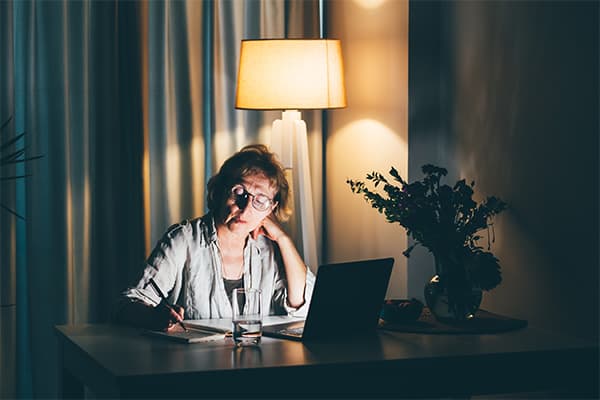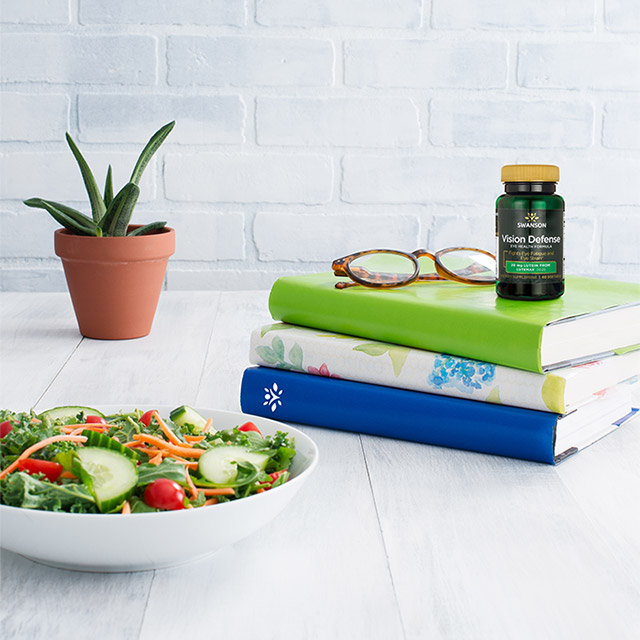Important Facts about Blue Light and Eye Health
The Facts on Blue Light Fatigue
Did you know the average American spends more than seven hours in front of an electronic device every day? We look to our devices for everything from productivity and education to entertainment. But all that time in front of our computers, tablet devices, phone screens and televisions exposes us to harmful blue light that can add up over time and lead to issues with eye health and even sleeping patterns.1

Studies have shown that too much blue light exposure can disrupt our circadian rhythm (our sleep and wake cycle), especially if we’re exposed to blue light sources at night, because blue light suppresses melatonin.2 Blue light exposure can also cause digital eye strain and eye fatigue, which can lead to blurry vision, difficulty focusing, dry and irritated eyes, fatigue, and even neck and back discomfort.
Thankfully, intriguing research has shed some light on how we can help protect ourselves from blue light damage with two antioxidant carotenoids: lutein and zeaxanthin.
Lutein & Zeaxanthin for Vision Health
The protective qualities of these macular carotenoids have been the focus of studies in numerous areas of health, but one study has taken a deeper dive into how lutein and zeaxanthin work to support healthy retinas.
The study was published in Nutrients, an open-access journal of human nutrition. Researchers revealed that a specific blend of lutein and zeaxanthin, known as Lutemax 2020, helps protect retinal photoreceptors against blue light by combating oxidative stress, which is the primary contributor to vision concerns related to blue light exposure.3
While this was a non-human study, it may have important implications in human health, especially given the onslaught of blue light exposure that we face each day.
What is Blue Light?
Why is blue light so different from other types of light? Put simply, blue light has a shorter wave length and higher frequency than red light.4 Blue light is also closer in the color spectrum to nonvisible, ultraviolet light than other visible light, like red or orange.5 Unfortunately, the natural filters in your eyes don’t sufficiently protect against blue light, meaning it can cause vision issues over time.
Here are some eye-opening facts about blue light:
- Sunlight is the biggest natural source of blue light. Artificial sources of blue light include smart device screens, fluorescent lights, and TV screens.6
- Electronic sources are the largest overall source of blue light in our modern lives, as we spend around 90% of our day indoors with these technologies.7
- The average American adult spends about seven hours per day on electronic devices.8
- Teens spend around nine hours each day in front of a variety of screen types, including TVs, cell phones, computers and tablets.8
- Around 65% of American adults report experiencing digital eye strain linked to the blue light emitted by electronic devices.9
- Accumulating in the retina, the carotenoid lutein (joined only by zeaxanthin) provides targeted support for ocular health by absorbing blue light.10
Lutein and Zeaxanthin for Eye Health
One of the most effective ways to protect yourself against blue light exposure is to enrich your diet with lutein and zeaxanthin. These two carotenoids are in the same family of nutrients as beta-carotene, but they are specifically referred to as macular carotenoids because they are deposited in the macula (a part of the retina) when consumed.10 As a member of the xanthophyll family, lutein and its related compounds are found in brightly colored fruits and vegetables, especially in green leafy vegetables. The unique yellow-orange pigment of lutein not only adds vibrant color to foods, but also helps to filter blue light. Swanson’s lutein supplements are a convenient way to get the benefits of lutein if you feel you’re not getting enough fruit and veggies in your diet. By supplementing with lutein, we can harness the power of color to promote healthy eyes and vision.
Lutein and zeaxanthin carry with them a yellow-orange pigmentation which absorbs blue light. The higher the density of macular pigment, the more protection you have.11 Lutein and zeaxanthin also have potent antioxidant benefits and play a role in protecting your retina from the cumulative exposure and oxidative stress that leads to age-related eye concerns.12
Ways to Support Eye Health Every Day
It isn’t possible to avoid blue light altogether, but you’ll want to take steps to protect yourself from the dangers of blue light as much as possible. Here are some tips for blue light protection:
- Limit screen time when not working. Grab a book, take a walk, choose screen-free activities to limit blue light eye strain.
- Remember to blink, blink, blink when using electronics.
- Set a time for “lights out” for your devices in the evenings.
- Limit your screen time before bed and use night-time settings to minimize blue light.
- Follow the 20-20-20 rule: Shift your eyes to look at an object at least 20 feet away for at least 20 seconds every 20 minutes.
- Consider adding supplements with lutein and zeaxanthin to your daily routine like our Age Related Eye Support or Synergistic Eye Health for blue light eye protection.
Ways to Help Promote Eye Health
Help protect your eyes from the effects of blue light by enriching your diet with supplements formulated specifically for ocular health. Look for supplements that contain both lutein and zeaxanthin, the two carotenoids that have been scientifically studied to protect against blue light damage. An easy way to incorporate these nutrients into your diet is Swanson's delicious lutein and zeaxanthin Blue Light Protection gummies which feature a tasty mango flavor. Another popular option is Swanson's powerful Age Related Eye Support, specifically formulated to help promote eye health, especially for concerns about the effects of blue light, while providing additional antioxidant benefits from other nutrients like zinc, copper and vitamins C and E. This formula also features high-quality Lutemax 2020 lutein from marigold extract derived from non-GMO flowers. These flowers are rich in bioavailable lutein and lutein esters, making them an ideal source of this essential nutrient.
*These statements have not been evaluated by the Food and Drug Administration. These products are not intended to diagnose, treat, cure, or prevent any disease.

Lindsey Toth, MS, RD
Lindsey is a nationally recognized registered dietitian and nutritionist with a soft spot for ice cream. She empowers people to take charge of their health by finding the balance between the pleasure and nourishment in food. Her philosophy is that you should take care of your body because it’s the only permanent home you have. It’s what inspired her to pursue a career in nutrition.
Sources
1. A Review on the Current State of Research on Blue Light. National Library of Medicine. Read source
2. Blue Light has a Dark Side. Harvard Health Publishing. Read source
3. Lutein and Zeaxanthin Isomers. Nutrients. Read source
4. Wavelength of Blue Light and Red Light. Center for Science Education. Read source
5. Visible Light. NASA. Read source
6. How Blue Light Affects Your Eyes. UC Davis. Read source
7. A Review on the Current State of Research on Blue Light. National Library of Medicine. Read source
8. Average Screen Time Statistics (2024). What's the Big Data? Read source
9. Digital Eye Strain. Ophthalmology and Therapy. Read source
10. Lutein and Zeaxanthin. Nutrients. Read source
11. Macular Pigment. Piedmont Eye Care. Read source
12. Macular Carotenoid Supplementation. Foods. Read source





